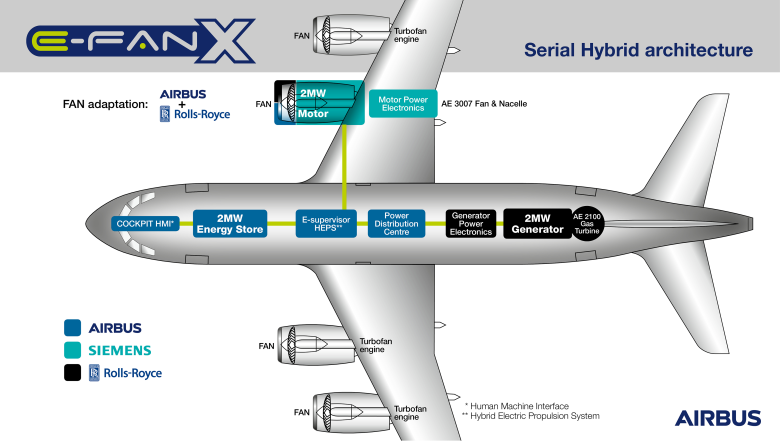Airbus, Rolls-Royce and Siemens create hybrid-electric aircraft

The first flight of the hybrid electric demonstrator E-Fan X is expected in 2020
As in the automotive industry, the aviation industry is also gradually preparing for the transition to electric motors. Here too, at the first stage, hybrid power plants appear, because modern batteries even cannot closely match energy density with chemical fuel. For example, in lithium-ion batteries, the energy density is 100-150 W ∙ h / kg, in lithium-polymer batteries - 150-200 W ∙ h / kg. For comparison, gasoline - 11000 W ∙ h / kg, hydrogen - 33000 W ∙ h / kg. So first there will be hybrids: with gasoline and electric motors. Some experts in the aviation industry believe that the future of aviation is uniquely behind hybrid-electric machines, and only then for purely electric ones. Here the development trajectory is the same as that of cars.
An interesting experiment in this area is conducted by Airbus, Rolls-Royce and Siemens. These companies have formed a partnership to develop a demonstrator, which will be an important step towards hybrid-electric commercial aviation.
The creation of an alliance with the involvement of "one of the world's best experts in electrical technology and power plants" was announced at the event of the Royal Air Navigation Society in London.
The first flight of the hybrid-electric demonstration aircraft E-Fan X is expected in 2020 after extensive ground tests, where BAe 146, a commercial mid-size jet aircraft produced by British Aerospace (Great Britain) from 1983–2003, is used as a “test bench”.
During the tests, one of its BAe 146 turbofan engines will be replaced by a two-megawatt Siemens motor. When the system proves its viability, an attempt will be made to replace another “turbine”.
Each of the three companies in the alliance has its own area of responsibility. Airbus is responsible for the overall integration of all components, the hybrid-electric plant and battery management system, and integration with the flight controls. Rolls-Royce will provide a free-turbine turboshaft engine, a two-megawatt generator and power system electronics. Together with Airbus, they will work on a fan fixture with an existing nacelle and a Siemens electric motor. Accordingly, Siemens will provide a two-megawatt electric motor and a power source for it, as well as an inverter, a DC-DC converter and a power distribution system.
Airbus Chief Technical Officer Paul Eremenko says that the E-Fan X will be an important step towards hybrid-electric commercial aviation and will continue the glorious history of previous demonstration models that have experienced electric traction: from Cri-Cri, e-Genius, E- Star and ending with the latest test aircraft E-Fan 1.2. Airbus has a long history of testing electric aircraft using the Airbus E-Fan program, and since 2016 Airbus has been working with Siemens on the E-Aircraft Systems House program.
The E-Fan X test machine will help to study the problems that arise in high-power hybrid-electric power plants: thermal effects, electrical control, the effects of altitude and speed on electrical systems, as well as electromagnetic compatibility problems. This program will also help bring up a new generation of engineers and designers who will determine the face of aviation of the future. Paul Eremenko is confident that the future of aviation is uniquely behind hybrid-electric cars.
It seems that other specialists agree with him. Including from Russia. For example, at the July MAKS-2017 airshow, the Russian Research and Development Center “Institute named after N. Ye. Zhukovsky” for the first time demonstrated parts of a model of a hybrid-electric power plant , in which the electric motor, a rotating screw and its control system are located in the nacelle. Reportedly, the main feature of the power plant being developed is “the use of electrical equipment with the effect of high-temperature superconductivity”. The planned nominal power of a promising hybrid electric power plant is 500 kW. At the first stage, efforts are planned to develop a hybrid-electric power plant on superconductors. Then, based on it, the serial electric motor for an aircraft for 9–19 passengers. The program is designed for three years.
All Articles